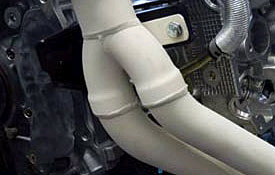Thermal insulation
Thermal insulation refers to the materials and methods used to reduce the rate of heat transfer between objects in thermal contact or in range of radiative influence. It plays a critical role in building construction, HVAC (Heating, Ventilation, and Air Conditioning) systems, and in numerous industrial applications. The primary purpose of thermal insulation is to enhance energy efficiency by maintaining a desired temperature within a space or object, thus reducing the energy required for heating or cooling.
Types of Thermal Insulation
Thermal insulation materials can be classified based on their structure, composition, and mode of heat transfer reduction. Common types include:
- Fibrous Insulation: Utilizes small diameter fibers that reduce heat transfer by trapping air. Examples include glass wool and rock wool.
- Cellular Insulation: Consists of small individual cells filled with a gas that provides the insulating effect. Polystyrene and polyurethane foams are typical examples.
- Granular Insulation: Contains granules that have pockets of air trapped within. Perlite and vermiculite are common granular insulating materials.
- Reflective Insulation: Works by reflecting radiant heat, rather than reducing conduction. Aluminum foils are often used for this purpose.
Applications
Thermal insulation finds applications in various fields, including:
- Building Construction: Insulation in walls, roofs, and floors helps maintain the indoor climate, reduce energy consumption, and improve comfort.
- HVAC Systems: Insulation of ducts and pipes minimizes energy losses during the transportation of heated or cooled air and fluids.
- Industrial Applications: Insulation in industrial processes reduces energy costs, protects workers, and maintains the quality of heated or cooled products.
Measurement and Standards
The effectiveness of thermal insulation is measured by its thermal resistance or R-value, which indicates the material's ability to resist heat flow. The higher the R-value, the better the insulation's effectiveness. Standards for thermal insulation vary by country and application but generally include specifications for material properties, installation, and performance.
Environmental Impact
The use of thermal insulation contributes to energy conservation and greenhouse gas emission reductions by decreasing the need for heating and cooling. However, the production and disposal of some insulating materials can have negative environmental impacts. Therefore, the selection of sustainable and recyclable insulation materials is increasingly emphasized.
Challenges and Future Directions
Challenges in thermal insulation include improving the sustainability of materials, addressing fire safety concerns, and enhancing the thermal performance of insulation solutions. Future directions may involve the development of new materials with higher R-values, lower environmental impacts, and the integration of smart technologies for adaptive insulation.
This construction related article is a stub. You can help WikiMD by expanding it.
Transform your life with W8MD's budget GLP-1 injections from $125.
W8MD offers a medical weight loss program to lose weight in Philadelphia. Our physician-supervised medical weight loss provides:
- Most insurances accepted or discounted self-pay rates. We will obtain insurance prior authorizations if needed.
- Generic GLP1 weight loss injections from $125 for the starting dose.
- Also offer prescription weight loss medications including Phentermine, Qsymia, Diethylpropion, Contrave etc.
NYC weight loss doctor appointments
Start your NYC weight loss journey today at our NYC medical weight loss and Philadelphia medical weight loss clinics.
- Call 718-946-5500 to lose weight in NYC or for medical weight loss in Philadelphia 215-676-2334.
- Tags:NYC medical weight loss, Philadelphia lose weight Zepbound NYC, Budget GLP1 weight loss injections, Wegovy Philadelphia, Wegovy NYC, Philadelphia medical weight loss, Brookly weight loss and Wegovy NYC
|
WikiMD's Wellness Encyclopedia |
| Let Food Be Thy Medicine Medicine Thy Food - Hippocrates |
Medical Disclaimer: WikiMD is not a substitute for professional medical advice. The information on WikiMD is provided as an information resource only, may be incorrect, outdated or misleading, and is not to be used or relied on for any diagnostic or treatment purposes. Please consult your health care provider before making any healthcare decisions or for guidance about a specific medical condition. WikiMD expressly disclaims responsibility, and shall have no liability, for any damages, loss, injury, or liability whatsoever suffered as a result of your reliance on the information contained in this site. By visiting this site you agree to the foregoing terms and conditions, which may from time to time be changed or supplemented by WikiMD. If you do not agree to the foregoing terms and conditions, you should not enter or use this site. See full disclaimer.
Credits:Most images are courtesy of Wikimedia commons, and templates, categories Wikipedia, licensed under CC BY SA or similar.
Contributors: Prab R. Tumpati, MD






